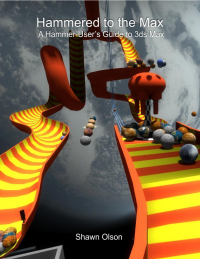Prop Data and Custom Gibs
The Prop Data and Custom Gibs rollout lets you control the physical attributes of a model for use in prop_physics and prop_physics_multiplayer props. These are props that can be pushed and broken in game.
To be a physics prop, the model must use a predefined Base type that defines most of the physical properties of the object. WWMT comes with many common base types such as Cardboard.Small, Item.Medium and Wooden.Large (among others).
- Not all base values in the default Base list are available for all mods. I have listed those that I found in the HL2 resources and some other common mods like CS:S and Portal. You should familiarize yourself with the base values available to your mod.
- If a base type that is available to your mod isn't in the list, you can type it into the text area at the top of the base list.
- When changing a base type, there are many default values (like dmg.bullet, Flammable, etc) that change internally. Those changes are not reflected in the UI! This is a limitation I may or may not change in the future. If you make no changes to the UI other than Base, the defaults of that base will be used in the compiler despite the values displayed in the prop data properties. In other words, only changes from the UI defaults are actually stored in the WWMT helper.
- If using $surfaceprop (in the main WWMT rollout) in the model, you must make sure that the surface property matches that of the Base. For example, if you use a Glass base but use a wood surface prop, the model may not work correctly.
Using Custom Gibs
For breakable models, you will notice that models often break into little pieces. For example, when you break a wooden crate, it often explodes into wooden shards that fly off, hit the ground, then often disappear in a few seconds. Those are called gibs.
By default, Source has four classes of gibs that you can apply to models: Wood, Glass, Concrete and Metal. The problem is that this may not be realistic enough for you.
With Wall Worm, you can easily create your own gibs for your model.
- Make the main model and choose the appropriate Base type.
- Make the individual gibs models that you want the main model to break into. You can use techniques like cloning the main model and detaching apprpriate elements into new objects; another useful tool is Rayfire for fragmentation.
- In the main model's WWMT helper, choose CustomGibs from the Gibs Model Class.
- Select all the pieces you want to add as gibs models.
- Press the Add Sel Gibs button.
- Each piece is now converted into its own WWMT helper.
- Press the Compile Gibs button to compile all the gibs models.
- Compile the main models.
More Notes
The Prop Data and Custom Gibs rollout works in conjunction with the Collision Model & Physics rollout. Your model must have a collision hull for the physics to work properly.
- If the model floats slowly to the ground, increase the Mass of the object in the Collision Model & Physics rollout.
- The more complex the collision hull is for your model, the more costly it is to simulate in game. You should make collision models as simple as possible for your physics props!





